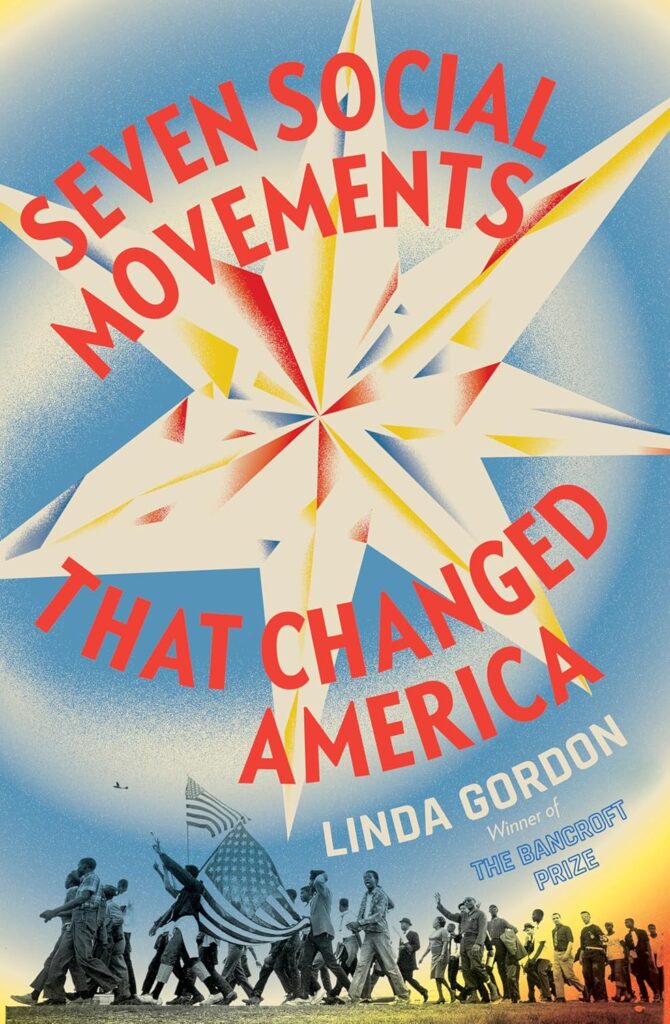Seven Social Movements that Changed America
Seven Social Movements that Changed America, by Linda Gordon (New York: Liveright, 2025)
What creates an effective movement?
Power comes from the people – and U.S. history is replete with grassroots social movements that shaped the nation. But what makes an effective movement?
There are lessons in Linda Gordon’s newest book, Seven Social Movements that Changed America. At first glance, one might wonder why the Ku Klux Klan and the civil rights Montgomery bus boycott are here together, but both were social movements, one repressive, one uplifting. In her examples, human solidarity is what propels movements. Leadership is critical, but the human response sustains the effort. An astute leader is critical and can often succeed or torpedo a fledgling effort.
She reviews seven movements; the settlement houses; Ku Klux Klan, the 1930s old age pension effort and unemployed councils, the Montgomery bus boycott, the United Farm Workers and feminist activism. Her comparisons help identify movement success and failure.
Chicago’s famed Jane Addams and her Hull House effort is contrasted with African American Jane Edna Hunter and her transition house for young women leaving the rural South. Addams and her middle- and upper-class cohorts created social work but soon learned that immigrant women had their own priorities. Hunter opened Phillis Wheatley Home in 1913 Cleveland for young women leaving the rural South. She helped them find jobs and created a secure environment, though the young women new to city life were eager to embrace urban bright lights. Though different, both were breaking new ground and creating women-controlled spaces.
Why the Klan? Although a reactionary movement with exploitative leadership, the Klan offered middle class, Protestant, small town, white America a sanctuary in a fast-changing world. The 1920s Klan grew quickly and faded fast, its leadership parasitic and exploitative. For its members reeling from World War I and afraid of immigrants, it offered a backward hope toward a supposedly idyllic rural past.
That same white, Protestant demographic seized on Dr. Francis Townsend’s 1930s Depression-era movement to establish old age pensions. Indignity often marked older Americans’ final years, dependent upon family or the “poor farm” for protection. Hope was brought to millions, and they found purpose. Through this effort seniors realized their power and a new political demographic emerged, still a powerful voting bloc.
The 1930s unemployed councils created an interracial movement. As the country sank into the Great Depression, Communists and Socialists sniffed revolution. Agitating for government jobs, unemployment insurance and decent housing, the councils united diverse working people for change. During deep economic dislocation, the councils broke people from isolation and self-blame. The participants wanted immediate needs met, not a revolution. This interracial movement was an important foundation for the 1930s Congress of Industrial Organizations mass unionization upsurge.
On December 1, 1955, no one predicted the modern civil rights movement’s beginning when Rosa Parks sat down on a Montgomery, Alabama bus. This not only launched a movement, but a leader, Dr. Martin Luther King Jr. Thanks to a solid religious foundation, the movement flourished. Men were the outward leaders, but it was African American women, already exhausted from a day scrubbing floors and housekeeping who walked through humid heat and thunderstorms, that was the movement’s foundation. Inspired by nightly church services, the bus boycott created a new Southern soul force that brought decades old segregation to its knees.
Can a leader become so valuable that the movement hesitates to challenge him, short-circuiting the effort? That’s the prognosis of the 1960s-1980s United Farm Workers (AFL-CIO). Cesar Chavez helped strategize a grass roots union campaign amongst impoverished farm workers, their plight magnified through urban grape and lettuce boycotts. The farm workers’ brave stance against corporate agribusiness gained national attention and sympathy for the impoverished workers. Hope, community and a better future inspired them. Yet there were cracks; Filipino farmworkers were critical to the movement’s launch but forgotten in Mexican-centered cultural trappings. The union failed to develop effective local unions and contract enforcement, as decisions were centered on Chavez. Those who criticized him were ousted as Chavez pursued an isolating spiritual quest. The perception that the movement resided in one valued individual thwarted the union’s expansion and growth, in Gordon’s analysis.
Finally, there is an in-depth analysis of the 1960s-1980s Boston feminist movement, which Gordon participated in. A new concept came from this effort – intersectionality – particularly in the different experiences of white and African American women. Each faced oppressive structures, but in unique ways. Consciousness raising circles gave everyone an equal voice, yet this very open-ended process often slowed efforts and thwarted emerging leadership. Women’s overwhelming voices brought social change in multiple deep ways, the movement’s diversity challenging sexist presumptions at multiple levels.
Gordon’s book is a great service; how do common people gain power and build a sustained voice? What is effective leadership and what is the critical role of grass-roots members? How does one take despairing situations and build community and hope for people? All excellent questions, which Gordon reflects well through the diverse movements she highlights.
Reviewed by Mike Matejka, a Vice President of the Illinois Labor History Society

